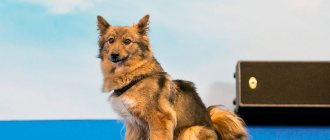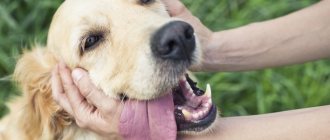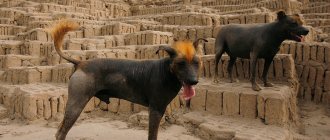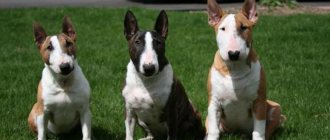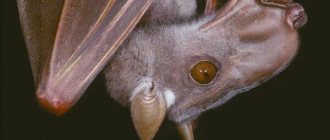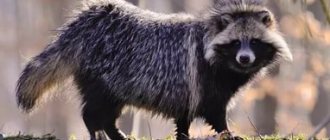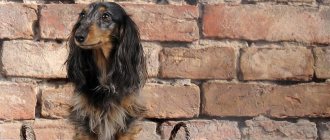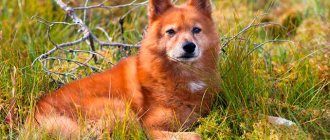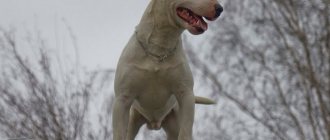Maintenance, care and nutrition
The dog must have his own place where he will not disturb anyone. It is necessary to keep the husky in the yard of the house, preferably in an enclosure. This is due to the dog’s character and active lifestyle. An animal adapted to cold weather can easily sleep in the snow thanks to its fur. The dog will not be comfortable in the apartment.
The walk should be away from the roadway and preferably away from people. If it is not possible to walk in the specified places, the dog must be walked on a leash.
During shedding, you need to comb the fur two to three times a week. And during the period of no shedding - once a week.
Laika is a clean dog, so it needs to be bathed two to three times a year. Ticks are checked twice a week. It would be right to treat your dog with special preparations against fleas and ticks before the summer period. This procedure will significantly reduce the presence of pests on the dog. The dog's sleeping and resting place should always be clean and free of hair and dirt.
It is advisable to perform a daily examination of the ears, eyes, teeth and nose:
- Ears are checked for cleanliness. If they are contaminated, this is a symptom of otitis media, allergies and tick bites. A slightly shiny coating is allowed.
- The presence of redness, swelling, white or yellow discharge in the eyes indicates the presence of an allergy or inflammatory process.
- The teeth are checked for the presence of tartar, as evidenced by the appearance of yellow discoloration.
- A healthy dog's nose is clean, cool and slightly wet. A sleeping dog or a dog that has just woken up can have a warm and completely dry nose.
You need to take deworming – baiting worms – very seriously. It is recommended to do it once every two months.
An adult husky should eat once or twice a day. If you lead an overactive lifestyle or during the cold season, the number of meals during the day can be increased. Otherwise, you can increase the serving size. Puppies need to be fed more often than adult dogs - 4-5 times a day.
Disadvantages and disqualifying vices
Airport workers focus not on external data, but on the service qualities of the dog
Any deviation from the characteristics described in the Jackal Dog breed standard should be considered a fault:
- roughness or looseness of build, short legs;
- pronounced tilt of the body;
- raw lips or eyelids;
- narrow shallow chest;
- motionless hanging tail;
- straightened angles of the front or hind limbs;
- saber tail;
- lack of undercoat;
- straight, soft, silky coat.
- aggressiveness and excessive cowardice;
- obvious physical or behavioral abnormalities;
- long hair, tight curl or cords on any part of the body;
- bobtail, docked tail;
- semi-erect or hanging ears;
- flesh-colored nose;
- undershot, overshot, jaw misalignment;
- absence of fangs;
- fangs growing into the gums or palate;
- blue eyes, odd eyes;
- clumsiness, constrained movements;
- blue, brindle, marbled color;
- smooth coat.
Particular attention is paid to male dogs, which should have two normally developed testes, completely descended into the scrotum.
Features of breeding
The main feature of the breeding of this breed was the use of the jackal as a “mating” partner for the dog.
Jackals have a uniquely sensitive sense of smell, which is very important for service breeds. But their skin and wool are not so well suited for extreme cold
But as for the “brides” - reindeer huskies, they feel quite comfortable in severe cold, and their instincts are considered one of the best among dogs.
Mixed blood
As already mentioned, to obtain the breed, a jackal from Central Asia and a Nenets Laika were mixed. In order for jackals to accept dogs normally when growing up, their puppies were fed by female huskies. And this helped, wild animals remembered the positive image of dogs from an early age.
After the first mixing, it turned out that the “half-breeds” were reluctant to obey humans and were poorly trained. Therefore, they were again crossed with the husky. As a result, when only a quarter of the blood from the jackal remained in the animal, it became more obedient.
Work on breeding the breed lasted about seven years. Now these dogs are bred mainly by security service workers.
Education and training
From an early age, shalaikas are able to solve complex problems. They are easy to train, but respond only to positive training methods. They do their work solely for a treat, and not because of their strong love for a person. Puppies begin to be trained at 2-3 months. The babies are kept separately in common cages and a leader quickly emerges among them. It is with him that dog handlers begin to work first. Then the whole group imitates him. The Aeroflot nursery does not disclose the specifics of training and its methods.
Training in detective work lasts about six months. After this, the dogs pass an exam and receive a certificate, which must then be confirmed every six months. It takes several days to add any smell to those already learned.
Our days
Jackalayas began to be used as search dogs only in 2002. Before this, quadroons were used by the KGB in the laboratory of the ECC of the USSR Ministry of Internal Affairs, after which exactly twenty-five individuals were sent to Sheremetyevo, where most often they had to look for dangerous explosives, something that the equipment would not see. In 2022, the jackalaika was added to the list of official breeds of the Russian Federation by the Russian Canine Organization. In fact, breeding of this breed is still ongoing. Unfortunately, you will not be able to buy such a pet dog for yourself, but it is difficult to call him a pet, the jackal genes do not sleep.
Shalaika, shakalaika or shabaka
Shalaika is an extraordinary dog. Thanks to the husky genes, she can withstand temperatures from minus seventy degrees and, thanks to the jackal genes, up to plus thirty degrees. A very useful quality for service in Russia. Shalaika is a small, agile dog with a well-developed sense of smell, thanks to which it can smell drugs, explosives, and find people. The probability of error is one in two hundred! That's why they are ideal bloodhounds. Surprisingly, this dog’s sense of smell is able to distinguish between the smell of a man and a woman. According to statistics, in 85% of cases crimes are committed by men, and if the shalaika determines that it is a woman, then the circle of suspects narrows. These dogs are not capable of making friends with people. They do not become attached to their owners. And so, these are very smart and intelligent dogs.
Appearance and characteristics
The first puppies meeting the requested requirements were obtained after 7 years of breeding work. And they combined the genetic data of a jackal and a husky, which are successfully used by security services.
Also, service dogs include such breeds as: Rottweiler, Cane Corso, Boxer, Newfoundland, Black Terrier, St. Bernard, Giant Schnauzer, Doberman
Description and photo
In appearance, representatives of this breed (which is also called Shalaika, Shakalaika, Quateron and even Shabaka) are dogs of the same type, somewhat larger in size than jackals (40-50 cm at the withers, weighing 12-15 kg). And they are superior to huskies in strength and tirelessness.
Shalaika is a dog that is distinguished by incredible agility and phenomenal resistance of the joints and musculoskeletal system.
The unique sense of smell, which was the goal of breeding this breed, is already evident in one and a half to two month old puppies. Shalika babies can detect an object that experienced adult search engines are unable to smell.
Important! Trained quarter dogs discover abilities that other dogs cannot demonstrate: they identify odors according to gender classification, i.e. can easily distinguish whether an object belongs to a woman or a man. The shalaika is unpretentious, intelligent and frost-resistant, capable of operating at temperatures from -70°C to +40°C
Shalaika is unpretentious, intelligent and frost-resistant, capable of operating at temperatures from -70°C to +40°C.
Character traits
Since the purpose of crossing the jackal and the husky was to breed dogs whose responsibilities include searching for drugs, explosives and other illegal items, this breed has purely working qualities.
Representatives of this breed never develop attachment to a person, and they are unable to love their owner. They work with such dogs only according to the “carrot and stick” principle.
Important! Many people consider the lack of affection to be an advantage of the breed - dogs can work with different people without problems.
The distinctive quality of shawls is their excellent learning ability and phenomenal sense of smell. These dogs are completely independent and can communicate with representatives of their breed, demonstrating unique abilities.
Character and behavior
By nature, shalaikas are very independent and freedom-loving, do not feel strong attachment to a person and instantly succumb to pressure from him. The dog will obediently walk on a leash, but at the same time loses all initiative and becomes unsuitable for work. Very sensitive emotionally with a developed pack instinct and the ability to adopt the habits of other dogs. Absolutely devoid of aggression, non-conflict. In many other respects he resembles an ordinary dog, he loves to play and frolic with his brothers, knows how to beg for goodies, and gladly accepts praise and affection.
Sulimov's dogs are very affectionate and friendly animals. They often show timidity towards people, and sometimes even outright fear. Very independent, smart and cunning, which is especially noticeable at work. They are distinguished by high adaptability and the ability to adapt to environmental conditions.
Story
It turned out to be quite a difficult task - crossing a jackal with a dog. They needed animals that were fed by a dog. It was then, in 1975, that by chance in Moscow, a female reindeer husky was given four jackal puppies brought from Central Asia. She fed them. Now we could start crossing.
Why was the jackal chosen as the dog’s “marriage” partner? The sensitivity of smell of these predators is unique, and they also like the heat. Only wool and skin, which are not particularly suitable for frost, fail. And the reindeer husky feels comfortable in the role of a “bride” in the most extreme cold, and its instincts are one of the best among dogs.
But feeding with huskies was necessary for a number of reasons:
- Growing up, little jackals normally accepted dogs as their own.
- Jackals from the wild refused to mate with dogs.
Half-breeds, as it turned out, were disobedient and difficult to train. A new crossing with a husky was needed. And now, when a quarter of the wild beast’s blood remained in the new offspring, the animal became much more obedient. By the way, this is where the nickname “quateron” comes from.
It took Klim Sulimov almost seven years before the result met his expectations, and he revealed a most unique animal to the world.
These dogs are unpretentious, frost-resistant, intelligent, like northern huskies, and gifted with a super-acute sense of smell, like jackals. They combine the ability to work at -70ºС, like arctic reindeer dogs, and at +40ºС, like heat-loving jackals.
Currently, their breeding is carried out primarily by security officers. Such dogs are in service at Sheremetyevo Airport. Due to their small size, they can even crawl under the seats on an airplane, leaving no corner unexplored. Here, on the territory of the airfield, there is also a nursery, where breeding work continues to this day, and even a Tu-154, long decommissioned, but very suitable for training.
Where to buy a Shalaika puppy
The only place where these super-sleuths are bred is the Aeroflot nursery, which is located near Sheremetyevo Airport. It is quite large, covering an area of about 2 square meters. km. There are about 50 working dogs and no more than a dozen veterans on site.
Shalaika, who retires, usually finds a place in good hands. Many are being held by security officers. The same fate awaits dogs that for some reason cannot work. We do not sell puppies. From birth they belong to the airline and are trained for detective work.
Dogs are not sold abroad and even those unfit for service are not given away. True, the shalaikas more than once went on business trips, where they showed their best side.
Thus, the only way to get a Shalayka is to adopt an adult dog from a kennel that has not been certified or has retired.
Price
The Aeroflot nursery does not sell Shalaika puppies. The price of adult trained detection dogs has not been disclosed. Klim Sulimov admits that they cost like a Mercedes.
Breeding work
Such a breed as the Sulimov dog was bred as a result of the work of a biologist. It took Klim a long time to come up with a hybrid that met all the requirements. The first brood, obtained as a result of crossing a jackal and a dog and fed by Nenets huskies, was distinguished by its impressive size, external characteristics characteristic of wild animals, as well as an unbalanced character.
Feeding a dog, according to the breeder, was supposed to imprint its image and make it predominant, determining belonging to this particular species. And yet the first mestizos were quite aggressive, unsociable and difficult to train.
Next, it was decided to cross the hybrids again, but with huskies, so that the jackal genes would be only 25%. But even after this crossing, problems arose, since some of the puppies were very wild and did not accept people, including the dog handlers involved in training. Further selection work made it possible to minimize negative qualities and obtain a hardy search dog ready for work.
External characteristics and habits
Sulimov's dogs are relatively small and very agile. Height is about 40-50 centimeters, average weight is 14-15 kilograms. In appearance there are features of both a husky and a jackal, which is clearly visible in the photo. The muzzle is elongated and pointed, the body is not very long and well developed, the hind limbs are somewhat shorter than the forelimbs. The ears are pointed, reminiscent of a wolf. The muscular system is perfectly formed and developed, the ligaments are incredibly strong, like the entire musculoskeletal system.
The breed has a rather thick and coarse coat; it is usually brown in color with light spots. There is a light spot on the chest, and the tips of the paws, as a rule, are also light.
Character traits
Sulimov’s dog has a difficult character; it certainly will not become a true friend and will not become attached to its owner, which is due to the genes of wild jackals. The tasks of this breed are completely different, and representatives cope with them perfectly. So, they learn well, and at an early age they even show interest in learning new skills. But the main incentive for them is encouragement in the form of some kind of treat; such dogs do not require the approval of a trainer or dog handler.
Sulimov's dogs do not become attached to people and even treat their owners rather coldly, maintaining a certain distance. This breed is distinguished by its willfulness and independence; its representatives are independent and often isolate themselves from other animals, but calmly communicate with their fellow tribesmen, and sometimes showing amazing qualities of mutual assistance.
Sulimov's dogs are fearless and brave, active, very mobile and energetic, they quickly carry out all commands, and at an early age they love to play, and with any objects. The animals cope well with their tasks.
Training
Such animals lend themselves well to training, but you should not show aggression or intolerance while learning new commands. Explain tasks clearly and reward your dog with treats. But there is no need to prove your superiority; anyway, the representative of the breed does not recognize him, just like human love and affection.
How to care for such a dog?
Complicated grooming is not required; it is enough to comb the coat regularly and comb it out during shedding, as well as carry out preventive treatments against worms, ticks and fleas. Nail trimming is unnecessary and unpleasant for your pet, so it is best avoided. Sulimov's dog can be bathed as it gets dirty; most representatives of the breed are not afraid of water.
Nutrition
The diet should include meat, fish, cereals, as well as fruits and vegetables, that is, everything that huskies and jackals usually eat.
Sulimov's dog is an amazing hybrid of a jackal and a husky, and now you know much more about it.
Shalaika's special abilities
- She can smell a sick person, who can only be distinguished from a healthy person by the results of a medical examination.
- They have surprisingly strong ligaments, and the entire musculoskeletal system. They talk about a case when a dog landed unharmed on its paws and ran away, jumping out of a fifth-floor window.
- They are the only known breed that can distinguish the sex of a person by smell. This is especially valuable for criminologists, as it allows you to significantly reduce the number of suspects and speed up efforts to find them. An ordinary dog, especially, cannot do this.
- They are capable of smelling explosives in minute doses with their incredibly subtle sense of smell. They tell how a dog smelled the smell of gunpowder in a suitcase hidden deep, on the packed suit of a man who had hunted in it some time ago.
- Even modern devices cannot compare with the ultra-precise sense of Sulimov’s dog. Only one time in two hundred can an alarm be false.
- A traditional breed service dog needs rest after half an hour of work. Sulimov's dogs are able to work up to 15 hours continuously (although they are replaced every half hour). And they don’t care at all that they are not recognized as a breed. They just work as if they were playing. And no other airport in the world has anything like this in its arsenal.
Origin story
Shakalaikas were bred by a leading researcher at the Research Institute of Cultural and Natural Heritage named after D.S. Likhachev Klim Timofeevich Sulimov. In the early 70s of the twentieth century, Sulimov worked in the forensic department of the Ministry of Internal Affairs for the fight against drugs. Well aware of the shortcomings of service dogs, he was enthusiastic about the task at hand - to breed small dogs that would be easy to train and have excellent sense of smell. When choosing the founders for the future breed, Sulimov settled on the jackal and the Nenets husky.
- The common jackal
is a small, almost omnivorous predator. Outwardly it resembles a wolf. Height at withers - 50 cm, weight - 10 kg. The color is zonal, the color depends on the habitat, varies from almost black to yellowish-red. The species is found over a wide area from Europe to East Asia. In nature, jackals are quite impudent and nocturnal. They are monogamous and choose a mate for life. Very smart and agile. - The Nenets Reindeer Laika
is an aboriginal primitive breed of small dogs of the Spitz type, which was formed in the tundra. For centuries it was used by the Nenets for grazing reindeer. Some dogs helped in the hunt, but the Nenets Laika was never a sled dog. She has a lively, active temperament, is very attached to her owner, and is people-oriented. She shows independence in her work and is freedom-loving. The colors are varied. Like the jackal, the herder has excellent health
For his work, Sulimov needed not just wild animals, but jackal cubs fed by a dog. In 1975 he received several from the Baku Zoo. The babies were placed under a Nenets reindeer husky, with which they were then mated. In 1977, the first half-breeds with an extraordinary sense of smell were obtained, but they were difficult to train and were very afraid of humans. In 1983, Sulimov already had quarter-blood dogs that met all his requirements. Hence one of the names of the breed is Quateron.
Selection work went on for 30 years, but with the collapse of the Union, the outstanding dog handler was sent to a well-deserved rest, and the project was closed. The dogs had to be placed with acquaintances and friends; a significant part lived with the creator on his pension.
The terrorist attacks that became more frequent in the 90s were undoubtedly a tragedy, but they were the ones that gave Sulimov’s dogs a second life. Many airports began to strengthen their own security, so jackalayas were invited to work in the Aeroflot security service, where the miracle bloodhounds soon began to force out shepherd dogs, Dobermans and other breeds from service. On December 19, 2022, the Shalaika breed group was officially registered in the RKF system.
Usage
Today, Sulimov’s dogs have only one purpose: to be a super-sniffer. Most representatives of the breed work at Sheremetyevo Airport, several dogs at Domodedovo and in law enforcement agencies. Dogs are trained to detect explosives, drugs and many other illegal substances. When detected, it gives a signal and sits down next to the object.
The main feature of hybrids is their super sense of smell. The ability to work in all weather conditions and crowded places is also valued.
The huts work with pleasure and interest, because this is an opportunity to have fun and get a treat. At airports, each round involves one dog and two dog handlers. Every time they make a pad for the bloodhound so that it does not lose interest in the work. If there are no smugglers on the rounds, the independent and dexterous shalaika will find a dangerous substance planted by the dog handler and receive meat for it. If she doesn't find anything for several days in a row, she will lose interest. The Shabaka works best in a free search, not on a leash. Searches the area quickly, but most importantly - efficiently.
The efficiency of Sulimov's dogs is 95%. The duration of the active search is about 30 minutes, then the dog needs a rest of 1.5 hours. It is interesting that the drooping tail indicates fatigue when it curls into a ring; the shawl is again ready for service.
Reviews about the breed
Our hybrids, or, as they can now be called, bastards, learn the necessary skills easier than traditional breeds, but require special education from an early puppy age.
K.T. Sulimov
https://jornal.drougmagazine.ru/dogs/stati/na-sluzhbe/unikalnye-sobaki-sulimova/
Hybrids are basically unpredictable. There were WOLF-DOGS in Perm, but... No matter how much you feed the wolf, he still looks into the forest.
parapaparam
https://www.yaplakal.com/forum13/topic1885110.html
Karim was defective - he had one drooping ear, but in all other respects he had all the initially promised advantages. For three years, he accurately predicted epileptic attacks in the owner's son and asthma attacks in his wife, and did not even let this same wife leave the house if she forgot to put an inhaler in her pocket. That is, it qualitatively made life easier for the owner. What Karim did on the street when he ran barking after some passing guy is unknown. You never know how many “alchemists” we have wandering around here. But, one way or another, he was lost. For a whole month. Small domestic dogs rarely live in the wild conditions of a metropolis for more than a week. They are simply eaten. This one not only survived, but did not even get lousy, like most of his brothers. Apparently, the jackal's blood took its toll. A cute, smart, nimble male, as if he had just been let off the leash, if you take him in your arms, he will “love” you to death. Not the slightest aggression.
karma-amrak
https://karma-amrak.livejournal.com/72913.html
The jackal dog is a unique new breed created by an amazing man, Klim Sulimov. It can be called the property of Russia. The dog was bred exclusively for service use; it is not very suitable for keeping as a pet or companion.
Origin story
Shalaika has many names - Sulimova's dog, quarterron, shakalaika. She was bred, as you might guess, by Klim Timofeevich Sulimov for the sole purpose of creating an ideal bloodhound. This goal has been fully achieved by the author of the breed. The dogs turned out to be very energetic, with an amazing sense of smell, while being unpretentious, hardy and hard-working.
Sulimov came up with the idea of breeding such a breed because he is familiar first-hand with the shortcomings of service breeds of dogs, first of all, their sense of smell, which is not capable of detecting the finest odors.
The task set before him was precisely to breed a breed that would have a heightened sense of smell, while at the same time being highly trainable. After much thought, Sulimov “laid” the Nenets husky reindeer husky and the jackal as the basis for the future breed. There are reasons for this. Jackals are omnivores, unusually smart, nimble, and small in size. As for the Nenets reindeer huskies, these are dogs belonging to the Spitz breed group, but formed in harsh tundra conditions. These are not sled dogs, but assistants in herding deer. With their barking, reindeer herders do not allow individual animals to disperse far from the herd, driving them together. They are temperamental, agile, attentive, and very attached to their owner. At the same time, they have such properties as independence and love of freedom, since they are accustomed to making decisions without the owner’s commands.
Breeding of the breed began with jackal chicks raised by dogs. Suitable puppies were found at the Baku Zoo; they were raised by a Nenets reindeer herder under the supervision of Sulimov. Mating of grown puppies was carried out with the same dog. The first cubs - half jackals, half dogs - were received only in 1977. Their sense of smell was super-strong, but it was impossible to train them; their fear of humans was insurmountable. After 5 years, dogs were obtained that had ¼ jackal blood, and they completed the task assigned to Sulimov. This is how the name quadron appeared. These puppies stopped being very afraid of people, began to chew the food offered to them more thoroughly, and not swallow it immediately, which is typical for jackals; accordingly, the process of their digestion was established, as was primary socialization.
Thanks to the sense of smell and omnivorous jackal genes, quadroons are able to recognize even the slightest traces of plant drugs, as well as synthetic drugs. This makes representatives of the breed universal bloodhounds, aimed specifically at searching for prohibited substances. Currently, more than four dozen shalaikas are working in the field of aviation security at various airports across the country.
Reproduction and lifespan
The Sulimov hybrid was bred and used exclusively for the purpose of detecting prohibited substances by smell. In addition to a fine sense of smell, the breeder is interested in good health, willingness to cooperate with humans, lack of attachment to a specific owner, and lack of aggressiveness.
All activities related to the production of Shalaika offspring take place in the Aeroflot service dog kennel. Puppies are born as a result of planned matings. The number of young animals produced annually is very limited. Dogs work actively for 10-12 years. The total life expectancy is 14 years. Which is a good indicator for service dogs.
How did the breed appear and develop?
The history of the appearance of the breed is quite short and began in the second half of the last century. The variety arose thanks to the Soviet biologist Klim Sulimov, who is still a leading expert in the field of cynology and continues his research.
Presumably in the 60s of the last century, he was tasked with breeding a dog that had an exceptional sense of smell and was distinguished by endurance. Then Sulimov was in the position of chief breeder of the special security service of Aeroflot, so he had to provide a breed that was supposed to become an excellent bloodhound and help during inspection, as well as in the search for suspicious objects.
Why did the biologist decide to combine the jackal and the husky? For example, wolves, which were also considered, were of considerable size and did not have such an outstanding sense of smell. The jackal has an impeccable sense of smell. In addition, it is practically omnivorous, and the bulk of its diet consists of plant products, for example, berries and grass. That is, such an animal, as it seemed to Sulimov, would be able to accurately identify narcotic substances made from natural raw materials. And the biologist was right. Another useful quality of the jackal is its resistance to high temperatures, which in the wild sometimes exceed 40-60 degrees.
As for the second component of the hybrid mixture, that is, huskies, it was also not chosen by chance. Firstly, this is an exclusively working breed, which means that it is very hardy. Secondly, huskies live in northern regions and withstand frosts, adapting to them. Thus, Sulimov created a breed that has an amazing sense of smell, and is also resistant even to significant temperature changes. And this is an ideal option for search work.
The first litters of the 1st generation of hybrids were obtained only in 1975, but research continued. And only at the beginning of this century (in 2002) Sulimov’s dogs began to be fully used in search service.
Description of Sulimov's dog
Quarteron is a unique dog. Shalaika feels equally comfortable in cold weather (even at -60-70 degrees) and in hot weather. Considering that the breed was created for Russian conditions, these dogs are simply ideal.
Quarterons do not differ in size and are short in stature. So, their length does not exceed 50 cm, and their weight rarely reaches 15 kg. However, unlike breeds mixed with wolves, shalaikas are stronger and larger.
Quarterons are distinguished by their activity and very acute sense of smell, because their sense of smell is their main advantage. There were cases when quadrons found truly unique objects: for example, a quadron discovered a part of an elephant tusk, which, in principle, had no smell and not every dog could smell it.
Another example of their sense of smell is an incident that also occurred during the inspection of the luggage of one of their passengers. The dog smelled something suspicious and raised its voice. Opening the bag showed that it contained only hunting clothes, which had traces of gunpowder. The clothes spent several days in the bag and the smell practically disappeared.
Shalaikas make mistakes very rarely: once every 200 cases. Their sense of smell is better than even special devices. Sulimov's dog has no price when it comes to their agility, because it gives them the opportunity to check the entire cabin of an airplane for explosives or drugs in a very short period of time.
Buy | sell
| I'll give it to good handsMoscowYesterday, 12:33 Beautiful mixed-breed husky puppies, 2 months old, very smart, domestic, different colors: gray, black, black and white. Very good dogs for a family with… |
| buyMoscow18 August 2020 Domestic mixed-breed puppies, 2 months old, g/w, different colors, will grow to be of medium size, very affectionate, cheerful and sociable, waiting for a reliable… |
| I'll give it to good handsMoscowApril 5, 2020 Cheerful Butch is looking for a home! Age: 3.5 years. Weight: 34 kg. Height: 65 cm at the withers. Healthy, vaccinated, neutered. Temperament/character: choleric and extrovert. ... |
| 10 Belgorod8 February 2019 West Siberian Laika puppies, born 12/21/19, two boys and two girls |
| 5000 NovosibirskOctober 11, 2018 Selling West Siberian Laechkas. Purebred. Parents are workers. D. r. 09/04/2022. |
| 5000 Krasnodar25 April 2018 Laika puppies, born on March 13th. 1 boy left -5000?, and 3 girls -3000? . Parents with a passport. Mom is pure white. I'll give in!!! |
| 40000 January 17, 2018 I am selling a male West Siberian Laika, date of birth November 17, 2016, origin (Zyar VPKOS No. 1987/11 - Umka St No. 391-1631/LZS) Male with character, ... |
| I'll give it to good handsMoscowDecember 10, 2017 Our dear Linda looks a little like a cute fox with a neat face and house-like ears. Linda is a West Siberian Laika mix. Very devoted... |
| I'll give it to good hands Moscow November 25, 2017 We present to your attention a West Siberian husky mixed breed named Chuk. Our Chuk looks like both his mother Laika and a real gray wolf. Special charm... |
| 12000 September 18, 2017 West Siberian Laika puppies with pedigree for sale. There are 4 males and 1 female in the litter. Parents at field tests have diplomas in bear, badger, ... |
| Norilsk27 August 2017 Husky puppies for sale. The West Siberian Laika is a Russian breed of universal hunting dog. A dog of average and above average height, strong, dry... |
| 13000 May 20, 2017 West Siberian Laika puppies for sale from working studs with a pedigree. Born on April 18, 2022. There are 3 males in the litter. and 3 females. Father is a worker... |
| I'll give 100 to good handsMoscowApril 5, 2017 I will give into caring and loving hands a very active, intelligent, kind and affectionate girl, a West Siberian husky mix. Age 5 months. Bonya has been processed... |
| 20000 Murmansk February 27, 2017 I will sell puppies with a pedigree (stamp and metric of the puppy). Born January 13, 2022. Working parents (confirmed by diplomas). Call for details. |
| 12000 Krasnoyarsk February 6, 2017 West Siberian Laika puppies for sale. The parents are of high breed, have EXCELLENT exterior grades, diplomas in bear, boar, badger, and squirrel. ... |
| 15000 ShaturaDecember 20, 2016 1. Breed: ZSL 2. Number of puppies (males/females): 2/2 3. Date of birth of puppies: October 23, 2016 4. Color: male No. 1: gray-red with white male No. 2:… |
| 1000 mating Podolsk November 8, 2016 Male ZSL for mating in Podolsk, Moscow region. From working parents. Works properly on squirrels. We can take two or three puppies. |
| matingBryanskOctober 24, 2016 Male Trans-Siberian Laika, with pedigree, age 2 years. |
| 12000 October 13, 2016 Laika puppies for sale. Breed: West Siberian Laika Number of puppies in the litter (males/females): 3/3 Date of birth of puppies: September 6, 2016 Color:… |
| 10000 September 12, 2016 I will sell West Siberian Laika puppies from working parents. Date of birth 08/22/2016 Parents are commercial hunting dogs, they work in the taiga fur... |
| Istra12 July 2016 wonderful puppies with excellent pedigree from real hunters. boys and girls. Inexpensive. Born May 30, 2016 |
| 5000 Novomoskovsk16 May 2016 Zapodnosiberian Laika puppies mom and dad with documents |
| 10000 KrasnoyarskMay 2, 2016 I will sell LZS puppies from working fur dogs. The puppies were born on March 25th. There are 2 males and 2 females in the litter. |
| I'll give it to good hands Kazan April 19, 2016 We will give a West Siberian husky puppy to our home. she is 1.5 months old, very cute. . . . . it's hard for her in the apartment |
| 10000 Krasnoyarsk April 7, 2016 I will sell Laika puppies from working, purebred Laikas. Puppies were born on February 20, 2016. Parents in the taiga work on sable, elk, badger and wood grouse. For sale… |
| 4500 Ryazan April 3, 2016 Selling puppies from working parents. bargaining is appropriate |
| 20000 Lyubertsy2 March 2016 5 puppies for sale, gray red color. Distribution of puppies, February 19. Father of the puppies p.ch. Grip line p.p.p.p. Zuban Vronsky A.Yu. bitch then male p.p. Vagaya… |
| matingKirovFebruary 25, 2016 We offer West Siberian Laika, male, 3 years old. Thoroughbred, with documents. |
| 1000 February 10, 2016 I sell West Siberian Laika puppies, born November 10, 2015. Parents are workers (ungulates, fur). Two bitches left. 8 (960) 545-98-11(Margarita) |
| matingSochiJanuary 27, 2016 |
Possible diseases
Some Xolo health problems can be inherited. Breeders must carefully monitor the purity of the breed, the absence of possible genetic abnormalities, and select physically healthy, mature (at least 2 years old) dogs for breeding.
Despite the fact that the Xolo's appearance is quite robust and inspiring strength, these dogs are also susceptible to disease. Their weak points are the knee joint and delicate skin, which can be susceptible to various dermatological diseases.
Overgrowth of the ear canals, umbilical hernia and hip dysplasia also occur. Visits to the veterinarian are mandatory, in particular for vaccination against a number of infectious diseases of dogs.
Origin story
The West Siberian Laika was bred by hunters and dog handlers based on several local offspring: Khanty, Ostyak, Mansi and Vogul Laikas, mainly distributed in the region of Northwestern Siberia and the Northern Urals. These dogs have long been famous for their large size, attractive appearance and working qualities. However, a more significant role in the development and formation of the breed was played by centuries-old strict selection of dogs for working qualities in the conditions of the harsh taiga. The fishermen did not keep parasites and tried to keep their best breeders with themselves, guarding the nests, and sometimes even hiding them.
One of the founders of the breed was a male named Grozny, who belonged to the Sverdlovsk Service Dog Breeding Club. He was born in 1930 and left behind many good descendants. The Sverdlovsk group remains one of the strongest to this day, although recently it has been slightly inferior to the Moscow one.
Of all the factory huskies, West Siberian huskies already at the end of the 50s represented a well-defined breed group. Moreover, breeders did not resort to inbreeding, but sought to consolidate the desired qualities by selecting similar sires of different bloodlines, which had a positive effect on the health of the livestock and its genetic potential
Health and major diseases of Landseer
The Landseer breed is predisposed to diseases of the cardiovascular system. The animal may develop problems with the joint capsules, but each individual is individual, and therefore requires regular preventive examinations and vaccinations.
In addition, chronic diseases of purebred Landseers include:
- chondrodysplasia is a common disease that cannot be cured on its own; individual treatment is selected by a veterinarian;
- heart disease is a real scourge of large dogs, but it can be avoided if you ensure sufficient activity and increased physical activity;
- obesity - can occur in an animal if it is constantly overfed or not provided with a sufficient amount of physical activity.
Your pet has a strong immune system, but it needs to be constantly fed. In order for the animal to be healthy, it is imperative to ensure activity during walks, balanced nutrition, and an organized daily routine. If everything is done correctly, the Landseer will be healthy and live at least ten or twelve years.
Shalaikas took over the security of Aeroflot
Aeroflot has registered a new breed group of service dogs in the system of the Russian Canine Federation. Now a hybrid of the husky and the European jackal – otherwise known as the shalayka – will serve on the airline’s staff. What is their advantage over other four-legged brothers, Boris Maksudov found out.
These four-legged security officers are always the center of special attention. During each such walk through the terminal, their sensitive noses analyze thousands of smells. Even curious passengers do not distract from such dog work.
Together with their partners, the dogs walk fifteen kilometers a day. Their area of responsibility includes Sheremetyevo terminals. They can smell all known explosives anywhere and in any situation.
This sensitive nose cannot be replaced even by the most modern technology. Thanks to the genes of the wild jackal and the domestic dog, the shawl can distinguish half a million odors and work even in the most extreme weather conditions.
Calm old age
In many departments that have their own canine service, there is a set period for the work of animals at certain facilities - 8 years. The experience of dog handlers shows that this is the optimal age to end a “career”.
In adult dogs, their metabolism gradually slows down and they become less active. Because of this, it is more difficult for them to work: airport patrol involves a fairly high pace and serious workload. Older shalaikas cannot withstand intense work and end their careers in the airline dog service, and are replaced by younger and more active “colleagues”.
When a dog approaches its age limit, dog handlers begin to look for a family or shelter for their charges. Indeed, despite a slight decrease in working qualities, the animal remains active and healthy in order to spend several more full years of its life with its new owners.
All airlines strive to find a new home for every four-legged “retirement” who served on them. Many dogs are taken in by dog handlers themselves: almost every specialized service worker has at least one shala. The rest are placed in reliable and proven shelters, where the animals are guaranteed to have decent living conditions.
Description of the breed according to the RKF standard
The main job of the shalaika is to detect explosive or dangerous substances
The breed standard was approved by the Decision of the Presidium of SOKO RKF on June 15, 2018. Shalaika according to the FCI classification belongs to the fifth group - “Spitz and primitive dogs”.
The purpose of breeding is detection (recognition) of odors. The dog is intended for official use and airport security work.
Shabaka in appearance resembles a medium-sized husky and is below average in height. The animal is of regular build, agile, harmonious, almost square in format. The ratio of body length to height at the withers is 10:9. The difference between males and females is not particularly pronounced outwardly.
- height 38–42 cm (deviation within 3 cm is allowed);
- weight not less than 7 kg and not more than 15 kg.
The peculiarity of the dog's appearance: in its muzzle and head structure it is similar to its wild relatives - jackals. This is expressed in the look, the shape of the eyes, facial expressions, and mobile, medium-sized erect ears.
The shawl has a non-massive muzzle with very well developed whiskers (vibrissae). The limbs can be described as dry, strong, but at the same time graceful. The short tail is normally carried over the back. The eyes are very expressive, the color varies from light to dark brown.
Sulimov's dogs are very active. Their movements are free and easy, well coordinated and fast. Running is characterized by trotting and ambling, easily turning into a gallop.
The medium-length coat is characterized by the so-called wild type of hair, the guard hair is coarse, the undercoat is soft. Outwardly, this makes the dog bulkier.
Jackalayas have a special structure of paws (front and rear). The middle pads can be fused, resembling a heart in shape. This structural feature, inherited from the jackal, is regarded as a morphological characteristic desirable for the breed.
White markings are allowed in any color variant of the shawl.
There are many color options for dogs of this breed. The most common:
- zonal gray;
- zone-red;
- red of varying intensity;
- sable;
- with or without a dark mask.
All colors can have white markings, perhaps a small speck.
Choosing a puppy and price
Shalaika puppies need early socialization, otherwise the dog will be overly cowardly.
It is not possible to buy a jackal dog puppy for private ownership. These animals are bred exclusively for work.
Theoretically, choosing a puppy is quite difficult - the breed does not have strict color requirements; individuals are very diverse in appearance. One litter can have puppies with different coat types. To an inexperienced dog breeder it may seem like these are just mongrels.
Since the dog is for official use, the experts have their own criteria: it must have good search data and dominant properties, and this is inherited. Therefore, to choose a good puppy, you need to look at the pedigree: more jackal genes mean that the dog has a better sense of smell.
Sulimov's dog can only fall into private hands in old age or if due to some disqualifying defects it cannot be hired.
Laika - a dog for hunting
All dogs of the Laika breed are distinguished by their sensitive sense of smell and loud bark. This helps them track an animal while hunting and tell a person its location. Hunting dogs are hardy, four-legged human helpers do not lose their sense of smell after many hours of work. They are capable of tracking animals alone, as well as working harmoniously in a team with fellow tribesmen and humans.
Laikas are versatile hunting dogs. The breeds included in this group work successfully in tandem with a hunter, helping to hunt different types of game.
How does a Laika dog behave when hunting?
- waterfowl - tracks a bird by smell, after shooting, takes the prey out of the water and brings it to the hunter;
- small game - tracks, bites the neck without damaging the skin;
- birds (grouse, black grouse, hazel grouse) - sneaking close to the bird, barking informs the owner of its location;
- sable, squirrel - tracks, drives into a tree, does not allow him to go down, barks to call the hunter;
- bear - helps to track, barks, telling the location of the animal, bites the legs, not allowing it to leave.
Important: The main function of a dog is to track game and bark at it. Laika distracts the animal from the hunter and points the person to the location of the game.
What is the Laika breed?
Laikas are dogs that can often be found in northern latitudes. These are friendly, hardy, hard-working hunting dogs for hunting animals and birds. Laika (from the word “bark”) is a generalized name for a species that unites several breeds. This list is not final; new ones are added to it as they are developed and recognized by domestic and world canine communities.
Within species, there are three main types of dogs:
- Riding.
- Hunters.
- Shepherds.
